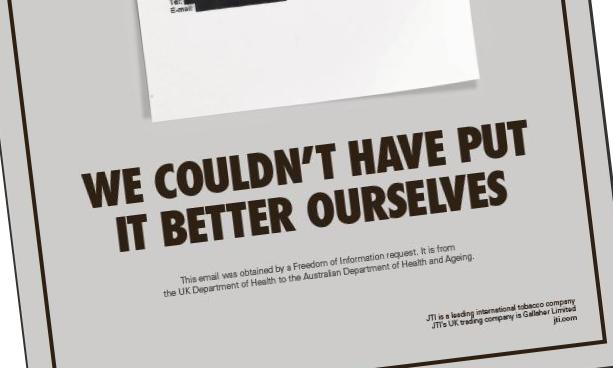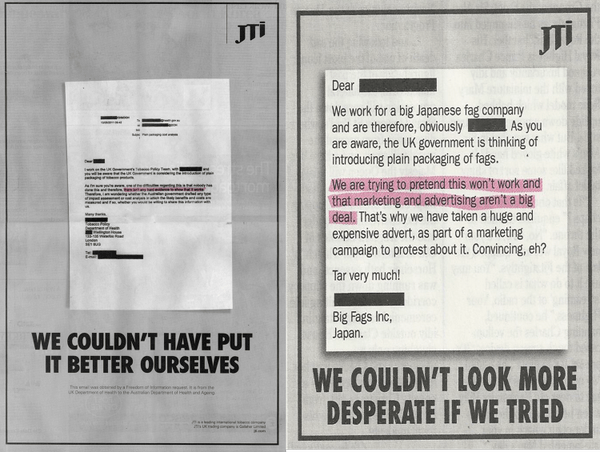Corporate Political Advertising on Plain Packaging
This page was last edited on at
Imperial Promotes Opposition to Plain Packaging

On June 14th 2012, The House, a weekly political magazine delivered directly to Members of Parliament (MPs), Peers, and civil servants, was presented in a plain gold cover, over the standard issue cover, with the warning “Plain Packaging: Bad for Business Good for Criminals”.1
On this advertising cover there was no disclaimer to tell the reader who had requested and funded it. On page 19 of the magazine, a second gold coloured, full-page advert claimed that plain packaging would not benefit wholesalers, consumers, business, retailers or the government, but would only benefit criminals. The advert featured the logo of Asian Trader, a trade magazine, and in small font at the bottom of the page explained: “This advert has been produced and placed by Imperial Tobacco in association with Asian Trader magazine.”1
The arguments used echo those that have been made time and time again by transnational tobacco companies234 and front groups such as FOREST 5 and the Tobacco Manufacturers’ Association.6
By allowing Imperial Tobacco to include an ad such as this, The House magazine enabled Imperial Tobacco to promote its anti-plain packaging agenda to the readership of The House, i.e. MPs.
MP Stephen Williams wrote a letter to The House magazine, suggesting that a disclaimer should have been more prominently placed on the magazine cover and questioning why such a misleading advertorial was permitted in the publication at all, given that tobacco industry advertising is illegal in the UK. Gerry Murray, a publisher of The House magazine defended the inclusion of such an advertisement by saying “Neither House magazine nor Dods operates a discriminative policy on who can and who cannot insert advocacy messages in the magazine. If they are within the laws of the land and the principles of common decency, in the interests of free speech we do not censor these messages. Whatever our personal views on smoking we cannot in all fairness exclude the tobacco lobby from the pages of the magazine. There lies a road to perdition, where would one stop?”
Murray also presented the argument often used by the industry that the plain packaging cover was “not about promoting smoking. It is about counterfeiting which is an issue that affects many of our clients some of whom are indeed part of the tobacco lobby.” It is unclear whether Mr Murray was aware of the industry’s use of the counterfeiting argument as a tactic to stall the passage of plain packaging legislation and that evidence to support this position comes from industry funded reports from third party organisations.
A week later, on the 21st June 2012, The House magazine featured a statement acknowledging that the front cover on the previous issue should have included an attribution of funding by Imperial, adding that the cover “in no way represents the views of The House Magazine.” 7
Japan Tobacco International Conducts National Anti-Plain Packaging Campaign in the UK
March 2012: “It’s not worth the paper it’s written on”
Japan Tobacco International
(JTI), the owners of Gallaher in the UK, have also been involved in campaigning against plain packaging. Just 24-hours after the British government announced a 4-week extension to its initial consultation on standardised packaging in July 2012, JTI launched a campaign costing £2 million “to share its views” on the potential outcomes of plain packaging legislation.89
10
This first wave of JTI advertising on the matter suggested that there was no evidence that plain packaging would work, using slogans such as “It’s not worth the paper it’s written on” (see Image 2). JTI claimed that their budget for the campaign was to ensure a wide reach of its messages to JTI’s target audience- “both government and decision makers”.9 In July 2012, these ads were included in a number of daily newspapers including The Financial Times amongst others.
September/October 2012: “Why Make It Easier For Criminals To Make a Packet?”
In a follow-up advert disseminated in print and online JTI posed the question “how do you spot a fake pack of cigarettes?” The advertisements suggested that plain packaging would make it harder to detect counterfeit cigarettes, and that therefore the illicit trade would increase in an already booming black market.
This second wave of the JTI campaign promoted concerns about potential detrimental impacts of plain packaging on small businesses, and consisted of full page adverts in The Financial Times, The Times, The Telegraph, The Guardian and Evening Standard run over a two week period. Martin Southgate, Managing Director of JTI said that the second wave of the campaign “was timed to coincide with the party political conference season”, in order to reach an unprecedented number of MPs and opinion formers.11 This can be seen as an example of indirect lobbying.
The ads also appeared in online versions of the newspapers. Image 3 shows an example of an advert from The Guardian newspaper.
Image 4 shows another variation of the online ads that was posted on Twitter.
Complaints about both advertising waves were made by Action for Smoking and Health (ASH), ASH Scotland and Cancer Research UK to the Advertising Standards Agency (ASA).12 The first wave of JTI ads specifically claimed that the UK government had considered plain packaging previously and had “rejected” the idea “when it was found to have no credible evidence” for success.13 However, this was not the case. In 2008, the health secretary in the then Labour Government said that the government would “keep tobacco packaging under close review.”14 Furthermore, in March 2009 Baroness Thornton, Health Minister in the House of Lords at the time said of the tabled amendment to the Health Bill removing plain packaging: “We will work hard to ensure that the emerging evidence on plain packaging is kept under review, and the Government’s policy will change if and when that is appropriate.”14
JTI Ads Banned by the Advertising Standards Authority
On 13 March 2013, the ASA ruled that the first wave of JTI ads were misleading.
“We acknowledged the numerous statements regarding the issue of plain packaging which had been provided by JTI, and which they considered demonstrated both that the Government had rejected the policy in 2008 and that it had done so because it lacked the evidence to support it. However, although the Government had decided not to take forward the proposal for plain packaging in the same way as it did with other measures considered in the consultation, we understood that they had nevertheless intended to keep the measure under review and planned to re-assess it at a later date.
“We therefore considered that the claims in the ads that the policy had been ‘rejected’ in 2008 because of a lack of credible evidence gave a misleading impression of the position and action taken at that time by the government and concluded that the ads breached the advertising code.”14
A month later, in April 2013, the ASA ruled that the second wave of adverts (September and October 2012) were also misleading. JTI again made claims that could not be substantiated and breached the UK advertising code. The company cannot claim that “the black market in tobacco is booming”.
Cancer Research UK added some more detail about the unsubstantiated claims and the breaches of the UK advertising code:
“The ongoing use of such a large advertising budget to try to block this measure highlights the industry’s fear of how effective this move will be in reducing the attractiveness of their products.
“HM Revenue and Customs (HMRC) figures show that the illicit market for cigarettes in the UK has more than halved in a decade. The ruling noted that JTI had themselves acknowledged that the illicit trade in tobacco products has reportedly been a declining trend in the last ten years.
“JTI was also told it could not claim that the UK had suffered “£3 billion lost in unpaid duty last year”. The ASA noted that this figure was used by the HMRC when referring to an estimate revenue loss figure – which is in fact far lower.”15
April 2013: “We couldn’t have put it better ourselves”


Using a letter written by a Department of Health employee obtained via a Freedom of Information (FOI) request, JTI produced an ad portraying a picture of the correspondence with certain details blacked out (see Image 5). In the letter, the Department asked the Australian government what evidence they have to support plain packaging. JTI UK Managing Director Jorge da Motta told Packaging News: “We are using this media campaign to demonstrate that in 2011 even the Department of Health accepted that these proposals are not supported by any hard evidence”.16
When commenting on the ASA decision to ban JTI’s campaign for the second time, Sarah Woolnough, Cancer Research UK’s executive director of policy and information, referred to this new series of ads:
“As JTI released its latest round of national adverts last week, this decision comes as a timely reminder about an industry that simply cannot be trusted on public health policy. 207,000 11 to 15 year olds start smoking in the UK each year so it’s vital we continue to do all we can to prevent another generation becoming addicted to tobacco. Plain, standardised packs won’t stop everyone from starting smoking, but it will give millions of children one less reason to start.”15

Spoof
The JTI anti-plain cigarette packaging advert was widely discussed in the UK.
The British Lung Foundation tweeted this “hilarious spoof” by the satirical magazine Private Eye (see Image 7 or go here to get the tweet).
Evidence on Plain Packaging
The letter JTI used to prove that there is no evidence of the effectiveness of plain packaging was written in 2011, and since then, things have moved on significantly: a considerable amount of research into the potential consequences of plain packaging has been conducted.
The best overview can be found in Plain Packaging: a systematic review by the Public Health Research Consortium. This review outlines findings from 37 studies that provide evidence of the impacts of plain tobacco packaging. The review was conducted following the publication of the March 2011 White Paper Healthy Lives: Healthy People which set out a renewed Tobacco Control Plan for England. The report provides a comprehensive overview of evidence on the impact of plain packaging in order to inform a public consultation on the issue.17
|
TobaccoTactics Resources
- It will Lead to Increased Smuggling
- No Evidence Plain Packaging Will Work
- Developing the Intellectual Property Argument
- Plain Packaging in the UK